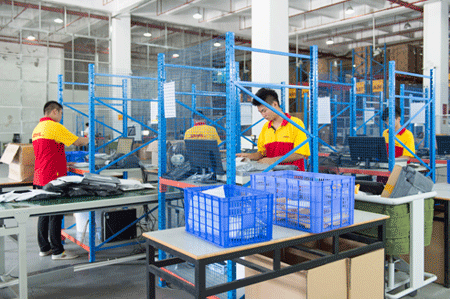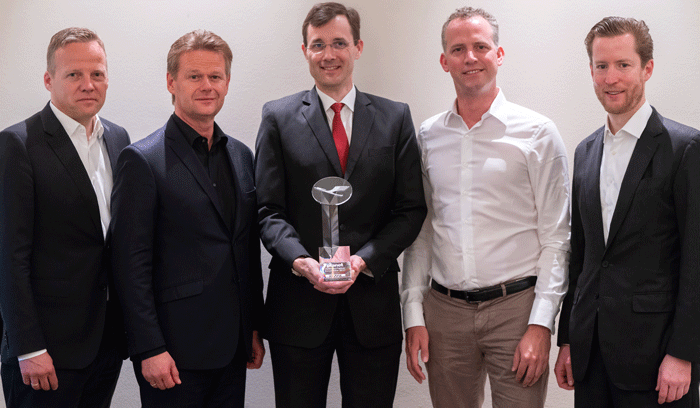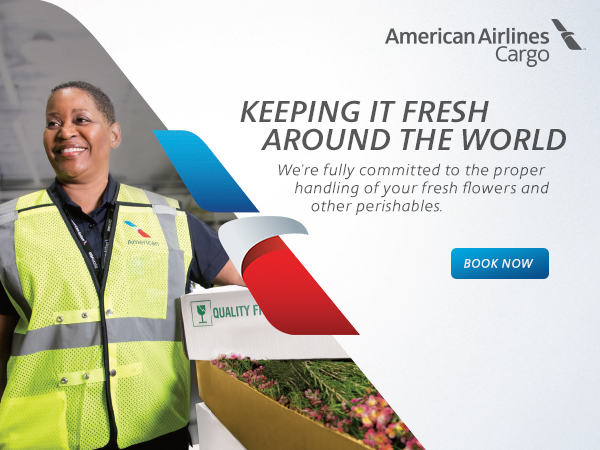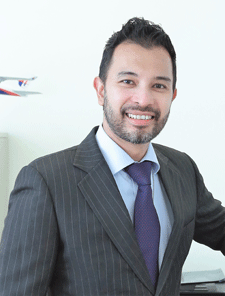|
(Exclusive)—Fast on the heels of
DHL’s latest quarterly report, FlyingTypers spoke to Tobias
Meyer, COO of DHL Global Forwarding (DGF).
Tobias Meyer was in expansive and optimistic
form, and with good reason. Deutsche Post-DHL Group reported decent returns
for the first quarter—year-on-year revenues suffered a slight drop
due to the sale of subsidiary Williams Lea Tag, but operating profits
rose 2.3 percent to €905m. DGF, the Group’s forwarding arm,
saw revenue rise 1.3 percent to EUR 3.6 billion in the period.
However, this did not tell the full story
because, once adjusted for negative currency effects, the latest numbers
actually represented a 7.2 percent improvement compared to a year earlier.
Even more impressive, DGF’s profit
surged 75 percent year-on-year to EUR 70m.
Overly Cautious
Predictions
Tobias Meyer is convinced the future is
bright, not least because he believes the 2018 air freight demand projections
by most analysts were overly cautious.
“Cargo volumes exported in 2017 total
up to around 24 million tons,” he said.
“The projection for 2018 is roughly
25 million tons, so an increase of approximately 4 percent.
“Looking at market growth rates for
just the beginning of 2018, I personally believe full year projections
are too conservative,” Mr. Meyer said.
A Closer
Look
Technology, Consumer, and Engineering—
by the main verticals on which the industry relies—have dominated
demand growth.
But Meyer also reported “very strong”
Perishable and Chemical product volumes and noted that since May 2016
there had not been a single month when growth rates in the Chemical sector
fell below 15 percent year-on-year.
Sensors &
Sensibilities
 He
also said e-commerce was rapidly transforming demand across verticals,
while the evolution of products and incorporation of new technology was
creating fresh opportunities for air freight forwarders. He
also said e-commerce was rapidly transforming demand across verticals,
while the evolution of products and incorporation of new technology was
creating fresh opportunities for air freight forwarders.
Illustrating the latter point, he highlighted
the growing use of sensors.
“Numerous products across different
industries have measuring devices installed,” he explained.
“And the trend is increasing at a
fast pace.
“Think about ‘Smart Homes’
with their intelligent refrigerators, air conditioning, radiators, etc.
“Movement or altitude measures are
installed in nearly every single mobile phone nowadays.
“Every halfway modern car on the road
has intelligent pressure control.
“These are just a few examples, but
there are definitely more.”
Paradoxically
Speaking
According to Tobias Meyer, these multiple
demand drivers have transformed air freight forwarding from a sellers’
market to a buyers’ market since late 2016.
“At present, demand is exceeding supply,
mainly fueled by the strong performance of the largest economies,”
he said.
“Given all the political tension and
talk about trade barriers this feels like a bit of a paradox, but this
is the situation at present.”
How About
Those Rates?
The imbalance of supply and demand has prompted
some carriers to reduce the share of capacity made available under block
space agreements to increase their exposure to spot markets.
“Price pressures are particularly
apparent outbound at major gateways in Asia Pacific and Europe,”
he said.
“In both geographical regions, average
buying rates have increased significantly by 20-30 percent, comparing
the beginning of this year to last year.
“Export rates in the Americas also
increased at a high single-digit rate during the same period.”
The DHL Action
“Our approach is to secure sufficient
lift and remain as independent as possible from the potentially expensive
and constrained spot-market.
“Even if we had some seasonal softness
in April also due to the phasing of some holidays, shippers will have
recognized the market has turned and accept the fact that rates have tightened
and pay a premium for capacity.”
Environmental
Impact
According to Mr. Meyer, space has been particularly
tight where regulations have limited capacity additions.
The Hong Kong Environmental Protection Department,
for example, last year introduced a noise quota scheme to reduce noise
pollution at HKIA.
Freighter
Cancellations
This meant non-compliant aircraft could
not operate at night, which had a major impact in Q3 and Q4. And, he added,
freighter service cancellations, particularly by Chinese carriers, have
increased.
“We saw months when 40 or 50 freighter
flights were cancelled out of Shanghai alone,” he added.
“Some of these flight cancellations
seemed to be intended to drive up load factors and carrier income.
“This creates challenges for freight
forwarders, in particular during the Tech- and e-commerce driven Peak
Season outbound Asia.”
Challenging
Other Obstacles
Regulatory obstacles are also apparent in
non-Asian markets. In Europe, as reported in FlyingTypers, double-digit
growth at some leading hubs caused congestion last year as well as record
volumes. “The increase in demand for air freight coincided with
rising demand for leisure travel, with passenger aircraft and freighters
competing for the limited number of slots,” Tobias Meyer assures.
“As an immediate reaction, some high-profile
cargo carriers were forced to shift freighter flights from slot-constrained
Amsterdam to next door Liege or other nearby airports.”
He said addressing these shortages would
take time given the competing needs and different operational criteria
of passenger and cargo airlines.
“It is in the nature of the air cargo
industry that we need to flexibly respond to fast-changing needs,”
he said.
“Air cargo demand for new High-Tech
product launches that need to get into the retail shops, unforeseen demand,
or factory downtime cannot be addressed through a biannual routing schedule
alone.
“Unlike the passenger market, which
is a market dominated by return flights, cargo carriers connect cargo
flows using more complex routing and enabling one-way flights.
“The greater share of cargo moved
on passenger aircraft, coupled with slot scarcity and the fact that slots
are regulated through administrative bodies on international and regional
levels, means achieving short-term flexibility is increasingly demanding.”
No More Parked
Aircraft
Meyer believes that finding a short-term
solution to the lack of capacity to help bridge the gap between supply
and demand will be difficult.
“There are no suitable aircraft parked
in the desert anymore and most freighters on firm order—82 percent
to be specific—are destined for integrators,” he said.
“The remaining freighters on order
for conventional carriers, those that we partner with, serve the purpose
of fleet replacement rather than new capacity additions to market.
“Given that airlines can often yield
more with passenger aircraft, airlines have also no real incentive to
convert to freighters.”
Leading The
World
“DGF,” he insisted, “maintained
its position last year as the world’s leading air freight forwarder
in terms of volume and footprint despite turning away some business.
“In 2017, we consciously stepped back
from some volumes,” he explained.
“We have witnessed a number of very
powerful global trends—double-digit growth in general air freight,
double-digit growth in Express volumes, double-digit growth in e-commerce—married
with stagnant growth in freighter capacity.
“Buying rates react to shifts in supply
and demand.
“We had to release some contracted
business during the course of 2017, because profitability was not attractive.”

From left to right: Sören Stark
(COO Lufthansa Cargo), Peter Gerber (CEO Lufthansa Cargo), Tobias
Meyer (COO DHL Global Forwarding), Hendrik Venema (Senior Vice President
Global Head of Network Carrier Management, DHL Global Forwarding),
Alexis von Hoensbroech (CCO Lufthansa Cargo).
DHL Global Forwarding received
the 2017 “Planet Award of Excellence” from Lufthansa
Cargo on May 24, garnering the award for the fifth time since its
inception in 2002.
Tobias Meyer, COO DHL Global Forwarding said,
“We are very pleased to receive this award again. Our customers
in particular benefit from the excellent cooperation with Lufthansa
Cargo, which has been outstanding for many years. And that in turn
contributes sustainably to our joint success.”
DHL Global Forwarding is one of Lufthansa’s
eleven Global Partners, who account for around half of Lufthansa
Cargo’s revenue. |
Diverse Approach
“When looking at DGF growth across
industry verticals, it is worthwhile to point out that some industry sectors
are dominated by a handful of very large shippers. If you have and keep
them, you grow with the market; if you give up one of them, you don’t
grow with the market. For us at DHL Global Forwarding, it is more important
to strengthen the portfolio in industry sectors which have a more diverse
structure.”
Of course, being part of one of the world’s
largest transport groups also benefits DHLGF, not least because of the
Group’s significant airfreight assets. However, Meyer downplayed
the advantages.
“An air freight forwarders’
business model is asset light by definition,” he insisted. “What
this means is forwarders generally do not purchase a fleet of aircraft
to accommodate air freight market demands.
“DHL Express, as an integrator, does
have a fleet of aircraft.
“Close cooperation with DHL Express
is a valid option, and wherever possible, we use them, but DHL Express
aircraft are very well filled with their own freight.”
However, despite being asset light, DHL
Global Forwarding does operate its own-controlled rotations through ACMI
contracts, which are deployed to the advantage of DGF customers.
“While own-controlled lift has a strong
value proposition for our customers and can provide some relief to capacity
constraints on certain routes, it only addresses a certain part of the
capacity demand,” he added. “Therefore, we also increased
our inventory of signed Blocked Space Agreements for 2018 to provide a
reliable service, despite paying higher rates for them,” Tobias
Meyer concluded.
SkyKing
|





 In
most places where it is hot or summer is approaching, comfort is measured
in British Thermal Units, or BTUs, pumped out faithfully by air conditioners.
In
most places where it is hot or summer is approaching, comfort is measured
in British Thermal Units, or BTUs, pumped out faithfully by air conditioners.
 Vol.
17 No. 31
Vol.
17 No. 31 